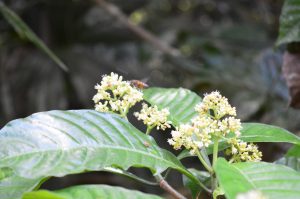Killer bees were spotted around the camp and on Elena’s hair. There is only one species of ‘killer bees’ in Belize that are particular aggressive: Africanized Western Honey Bee. When provoked, more individuals from a single colony is likely to sting a intruder than non-Africanized bees.

After breakfast, we set up camera traps to capture large mammals, hoping to find jaguars, pumas, and other wildcats. We hypothesized that off trail activity would be greater for these mammals because human activity discourages the presence of other mammals. 10 locations were chosen, 5 on trail and 5 off trail. Adrienne made special appearances on some of these traps as we were setting them, I wonder what they will look like once we collect our traps. As we walked on trails and loitered around traps, we set off the motion sensor and took many selfies in the process.
After carrying out our experimental methods, we listened to a lecture presented by the leader of Friends of Conservation and Development. Rafael updated us on the status of the forest conservation and the unique challenges faced by the conservationists because of the forest’s proximity to Guatemala. Poachers and loggers from Guatemala have been found in the Chiquibul extracting endangered species from the field for sale as products. Poor residents close to the boarder have few incentives to observe rules of the forest, as a single successful poach can give them the amount of money many day’s worth of work can provide. However, in the recent past, things have been improving due to rangers that patrol the area.
It was a day of much walking and we were more than ready for the night to come, and for much needed sleep.
